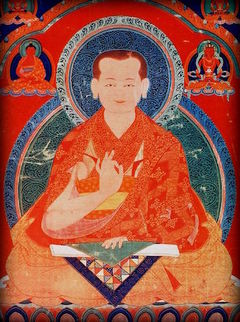|
Rongton Sheja Kunrig - Clarifying the Essence Source: http://www.lotsawahouse.org/bo/tibetan-masters/rongton/clarifying-the-essence Translation: http://www.lotsawahouse.org/tibetan-masters/rongton/clarifying-the-essence Markup of the Tibetan Sentence Structure - Particle - Genitive Particle - Sentence ending Particle - Nouns and terms (objects, subjects) - Verb -Adjective Note that nouns could have adjective and verb combinations for but the sake of structure clarity these cases are also marked as subjects. |
|
༄༅། །དབུ་མའི་ལྟ་ཁྲིད་ཀྱི་བསྡུས་དོན་སྙིང་པོའི་གསལ་བྱེད་ཅེས་བྱ་བ་བཞུགས་སོ།།
Clarifying the Essence: A Summary of the Instructions on the View of the Middle Way
by Rongtön Sheja Kunrig
Oṃ svasti!
བླ་མ་དང་ལྷག་པའི་ལྷ་ལ་གུས་པས་ཕྱག་འཚལ་ཞིང་སྐྱབས་སུ་མཆིའོ། །བྱིན་གྱིས་བརླབ་ཏུ་གསོལ།
In devotion, I pay homage to, and take refuge in, the guru and supreme deity: grant your blessings, I pray!
དབུ་མའི་ལྟ་ཁྲིད་ཀྱི་བསྡུས་པའི་དོན་ནི། ལྟ་བས་སྤྲོས་པ་མཐའ་དག་ཐག་བཅད། སྒོམ་པས་དོན་ཉམས་སུ་བླང་། སྤྱོད་པས་བོགས་དབྱུང་བའི་མན་ངག་གོ
The summary of the instructions on the view on the Middle Way includes advice on 1) decisively eliminating conceptual elaboration [1] through the view; 2) taking the meaning into experience through meditation; and 3) bringing about enhancement through action.
།སྒོམ་པས་དོན་ཉམས་སུ་བླང་བ་ལ་གཉིས་ཏེ། ཞི་གནས་དང་། ལྷག་མཐོང་ངོ་།
Meditation
Taking the meaning into experience through meditation has two aspects: 1) calm abiding (śamatha) and 2) penetrating insight (vipaśyanā).
།ལྷག་མཐོང་ལའང་གཉིས་ཏེ། གང་ཟག་གི་བདག་མེད་བསྒོམ་པ་དང་། ཆོས་ཀྱི་བདག་མེད་བསྒོམ་པའོ།
Vipaśyanā
The instructions on vipaśyanā themselves are divided into two: 1) meditating on the selflessness of the individual, and 2) meditating on the selflessness of phenomena.
།འདི་གཉིས་ཀྱིས་ནི། ཕྱི་སྟོང་པ་ཉིད་དང་། ནང་སྟོང་པ་ཉིད་དང་། གཉིས་ཀ་སྟོང་པ་ཉིད་བསྒོམ་པ་བསྟན་ཏོ། །
These two incorporate meditations on 1) outer emptiness, 2) inner emptiness, and 3) the emptiness of both [outer and inner].
བདག་མེད་གཉིས་ལ་བདེན་པར་ཞེན་པ་ཡང་གཅོད་དགོས་པའི་ཕྱིར་ན། གཉིས་ཀ་རང་བཞིན་མེད་པར་་བསྒོམ་དགོས་པས་སྟོང་པ་ཉིད་སྟོང་པ་ཉིད་བསྒོམ་པ་བསྟན་ཏོ།
As any attachment to the truth of the two forms of selflessness must also be eliminated, it is also necessary to meditate on how they both lack true reality, and so 4) the meditation on the emptiness of emptiness is also taught.
།སྟོང་ཉིད་བཞི་པོ་བསྒོམ་པ་འདིར་སྟོང་ཉིད་རྟོགས་པའི་ལྟ་བ་བསྒོམ་པ་ཐམས་ཅད་མ་ཚང་བ་མེད་པར་འདུས་སོ།
Together, these four forms of meditation on emptiness include all the necessary means of cultivating the view of emptiness, with nothing lacking.
།སྟོང་ཉིད་དང་པོ་གསུམ་བསྒོམས་པས་ནི་ཆོས་ཅན་ལ་སྒྲོ་འདོགས་གཅོད་ལ། སྟོང་པ་ཉིད་སྟོང་པ་ཉིད་བསྒོམས་པས་ནི་ཆོས་ཉིད་ལ་སྒྲོ་འདོགས་གཅོད་དོ།
Meditating on the first three forms of emptiness eliminates imputation[2] regarding phenomena (chos can; dharmin), while meditating on the emptiness of emptiness eliminates imputation regarding the nature of phenomena (chos nyid; dharmatā).
།ཞི་བ་ལྷས། གང་ཚེ་དངོས་དང་དངོས་མེད་པ། །བློ་ཡི་མདུན་ན་མི་གནས་པ། །དེ་ཚེ་རྣམ་པ་གཞན་མེད་པས། །དམིགས་པ་མེད་པར་རབ་ཏུ་ཞི། །ཞེས་གསུངས་སོ།
As Śāntideva said:
When notions of real and unreal
Are absent from before the mind,
Then, there is no other possibility,
But to rest in total peace, beyond concepts.[3]
།དབུ་མའི་ལྟ་ཁྲིད་ཀྱི་བསྡུས་དོན་རོང་སྟོན་ཆེན་པོས་དཔལ་ནཱ་ལེནྡྲར་སྦྱར་བ་མངྒ་ལཾ།།
This summary of the instructions on the view of the Middle Way was composed by the great Rongtön at glorious Nālendra. Mangalam.
| Translated by Adam Pearcey, 2016
- spros pa; prapañca
- sgro 'dogs; samāropa
- Bodhicaryāvatāra, IX, 34
